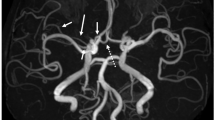Abstract
Introduction
Duplicate origin of the middle cerebral artery (MCA) is rare and has been misdiagnosed or confused as fenestration of the proximal M1 segment of the MCA. The condition is not a true fenestration and occurs when two MCA branches arise separately from the terminal segment of the internal carotid artery, and fuse to form an arterial ring. We researched our institutional records to determine the prevalence of such cases and investigated its characteristic features on magnetic resonance (MR) angiography.
Methods
To isolate these cases, we retrospectively reviewed cranial MR angiographic images of 3,491 patients obtained on either of two 1.5-tesla scanners at our institution from April 1, 2007 through December 31, 2009.
Results
We found four cases of duplicate origin of the MCA, two cases each on the right and the left (3 men, one woman), representing a prevalence of 0.11%. All four arterial rings were small and mimicked fenestration of the proximal M1 segment. During the same period, we found three MCA fenestrations, two at the proximal M1 segment and one at the middle M1 segment. Total prevalence of duplicate origin and fenestration was 0.20%.
Conclusions
In our institution, we observed 0.11% prevalence of duplicate origin of the MCA on MR angiography, and all were small and mimicked fenestration. Clinically, an important difference between duplicate origin and fenestration of the MCA is the potential collateral circulation available from the inferior branch in the case of saddle embolism occlusion of only the superior branch when there is duplicate origin of the MCA.




Similar content being viewed by others
References
Bharatha A, Aviv RI, White J, Fox AJ, Symons SP (2008) Intracranial fenestrations: frequency on CT angiography and association with other vascular lesions. Surg Radiol Anat 30:397–401
Crompton MR (1962) The pathology of ruptured middle-cerebral aneurysms with special reference to the differences between the sexes. Lancet 2:421–425
Gailloud P, Albayram S, Fasel JH, Beauchamp NJ, Murphy KJ (2002) Angiographic and embryologic considerations in five cases of middle cerebral artery fenestration. AJNR Am J Neuroradiol 23:585–587
Ito J, Maeda H, Inoue K, Onishi Y (1977) Fenestration of the middle cerebral artery. Neuroradiology 13:37–39
Komiyama M, Nakajima H, Nishikawa M, Yasui T (1998) Middle cerebral artery variations: duplicated and accessory arteries. AJNR Am J Neuroradiol 19:45–49
Padget DH (1948) The development of the cranial arteries in the human embryo. Contrib Embryol 212:207–261
Plumb AA, Herwadkar A, Laitt R (2009) Double origin of the posterior inferior cerebellar artery with findings on conventional and CT angiography. Surg Radiol Anat 31:393–395
Sanders WP, Sorek PA, Mehta BA (1993) Fenestration of intracranial arteries with special attention to associated aneurysms and other anomalies. AJNR Am J Neuroradiol 14:675–680
Suzuki S, Kuwabara Y, Hatano R, Iwai T (1978) Duplicate origin of left vertebral artery. Neuroradiology 15:27–29
Takahashi T, Suzuki S, Ohkuma H, Iwabuchi T (1994) Aneurysm at a duplication of the middle cerebral artery. AJNR Am J Neuroradiol 15:1166–1168
Teal JS, Rumbaugh CL, Bergeron RT, Segall HD (1973) Anomalies of the middle cerebral artery: accessory artery, duplication, and early bifurcation. AJR Am J Roentgenol 118:567–575
Uchino A, Kato A, Takase Y, Kudo S (2000) Middle cerebral artery variations detected by magnetic resonance angiography. Eur Radiol 10:560–563
Uchino A, Takase Y, Nomiyama K, Egashira R, Kudo S (2006) Fenestration of the middle cerebral artery detected by MR angiography. Magn Reson Med Sci 5:51–55
Ueda T, Goya T, Wakisaka S, Kinoshita K (1984) Fenestrations of the middle cerebral artery associated with aneurysms. AJNR Am J Neuroradiol 5:639–640
van Rooij SB, van Rooij WJ, Sluzewski M, Sprengers ME (2009) Fenestrations of intracranial arteries detected with 3D rotational angiography. AJNR Am J Neuroradiol 30:1347–1350
Vuillier F, Medeiros E, Moulin T, Cattin F, Bonneville JF, Tatu L (2008) Main anatomical features of the M1 segment of the middle cerebral artery: a 3D time-of flight magnetic resonance angiography at 3 T study. Surg Radiol Anat 30:509–514
Acknowledgments
We thank Rosalyn Uhrig, M.A., for editorial assistance in the preparation of this manuscript.
Conflict of interest
We declare that we have no conflict of interest.
Author information
Authors and Affiliations
Corresponding author
Rights and permissions
About this article
Cite this article
Uchino, A., Saito, N., Okada, Y. et al. Duplicate origin and fenestration of the middle cerebral artery on MR angiography. Surg Radiol Anat 34, 401–404 (2012). https://doi.org/10.1007/s00276-012-0936-9
Received:
Accepted:
Published:
Issue Date:
DOI: https://doi.org/10.1007/s00276-012-0936-9




